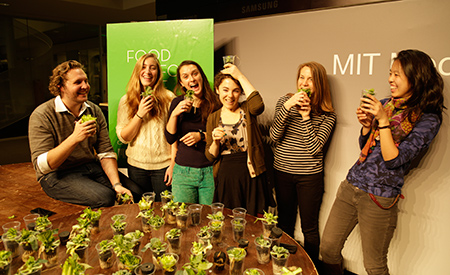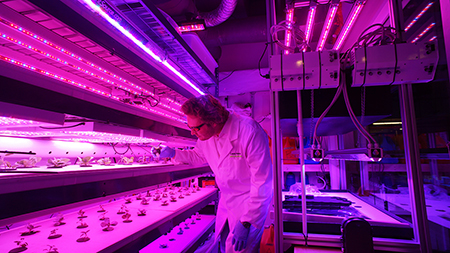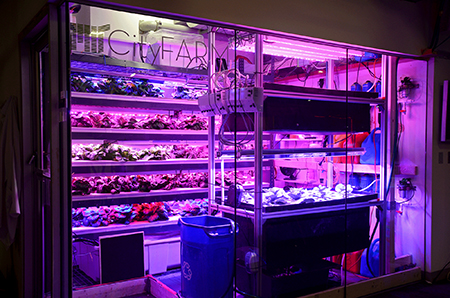Your Next Tomato Might Be Grown by Air
-
-
slice.mit.edu
- 3
Filed Under
Recommended
Founded by Caleb Harper MArch ’14, CityFarm is an MIT Media Lab initiative designed to explore the large-scale adoption of both aeroponics and hydroponics to “invent the future of agriculture,” according to their website. Unlike traditional farming, which irrigates and uses soil as structural support, an aeroponic plant’s roots are fed a mineral-enriched mist and protected in boxlike chambers. Plants are exposed to spectrally-optimized LED lights and are constantly evaluated to ensure optimum growing conditions.
The results? A head of romaine lettuce can grow in 19 days. By comparison, it takes 80 days to grow the same lettuce through traditional farming and 22 days using hydroponics, which submerges the roots in water.
Aeroponics uses 98 percent less water than conventional farming, and plants can grow 365 days a year inside and in much smaller areas. That’s a whole lot more veggies even during Boston’s chilliest winters.
 Harper and his team of farmers celebrate their first harvest this past November.
Harper and his team of farmers celebrate their first harvest this past November.
With recent estimates that 60 percent of the world’s population will reside in cities by 2030, aeroponics might be an increasingly common growing method in cities. Harper predicts city dwellers will be able to pick up their berries, lettuce, and vegetables at local growing sites right in their neighborhoods.
Back at CityFarm, the lab’s 1,500 plants provide Harper’s team with detailed data on embodied energy—exactly how much energy a plant needs to grow. Small radio transmitters on the lights, misters, and other equipment submit information on each kilowatt of energy used. Eventually equipment will tweet this data.
Such detailed tracking of energy inputs and produce outputs is new to farming. Often the energy required to power the tractor or transport tomatoes to the grocery store is rarely factored into the true energy requirements to grow produce. Harper hopes to change that.
Harper envisions launching an Open Agriculture Initiative in the next couple months with CityFarm hosting an open source platform of farming data to improve the evaluation of aeroponics and other farming methods. “We’re providing an economic and data-driven back bone for fundamental agricultural change,” he said.

He sees MIT leading the way in the new technology-agriculture space and encouraging cross-discipline scholarship between tech and agriculture universities. “I’m not competing with agriculture, I’m really providing networked intelligence and technological optimization that wasn’t there before.”
For now, Harper continues to taste test his lettuce plants in preparation for the upcoming harvest. “I have become a lettuce connoisseur,” he jokes.
For farm updates and news on the latest harvest event follow CityFarm on Twitter at @MITCityFARM.









Comments
Fred Lowry
Mon, 03/13/2017 1:49pm
CityFarm is a novel idea. Love it! I'd love to hear an update on how this project is progressing at MIT.
learnk12
Fri, 01/31/2014 2:41am
Cheers Caleb Harper, for the achievement. May this technology will serve quality food for thousands of peoples who are in Africa and Middle East, there is a scarcity for the pure water!
george
Thu, 01/30/2014 12:51pm
You need to upgrade your lights to artificial sunlight and then test plants.....bigger yield and better tasting.......good luck I will send up dated pictures of ours when we are done.....look up plasma-i.com they have the bad boy ones you want...